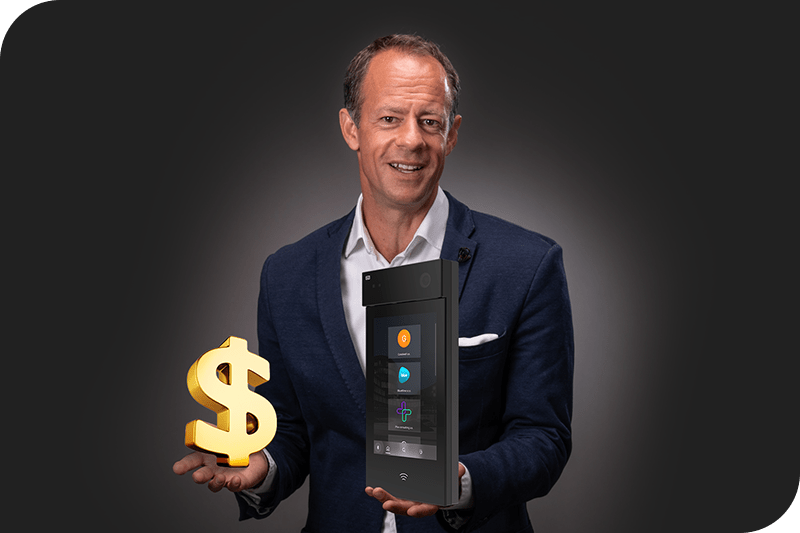How IP intercoms can save you considerable money (or even help you make some!)
The Cost Effectiveness of IP Intercoms - IP Intercom Benefits
 Camilla Ashdown, 14. 06. 2022 | 5 min read
Camilla Ashdown, 14. 06. 2022 | 5 min read
In the IP intercom industry, like the whole of the technology sector, there is a huge focus on innovation – on products and technologies which give consumers something they have never seen before. There are many pros and cons to IP intercom systems, and they can get demanding. It’s understandable: everyone loves new things, and it’s true that the IP intercom industry has been transformed by technological progress in recent years. Innovation is also exciting because, at least in successful companies, it never stops, with a constant impetus to open new revenue streams and create a competitive edge.

There is sometimes less focus, though, on what innovation is actually for. Put simply, it’s about responding to existing and emerging customer needs, which is why the best companies are the ones focusing most on not only innovation, but also their customer’s needs. Of course, customer needs evolve but I would argue the fundamental things don’t really shift at all. In fact, from the time the first IP intercom was introduced and the question ‘what are the advantages of IP intercoms’ first asked, new innovations in our sector have succeeded (or failed) based on the answer to three simple questions: Does it make people safer? Does it make people’s lives easier? Does it save customers money - or even help them make it?
The last of these questions – does it save or make customers money – is the one that gets the least attention. Genuinely innovative products are rarely cheap, so when new products come out, the focus tends to be solely on the security and convenience benefits. However, the reality is that IP technology is taking over the IP intercom world because it benefits customers in all three areas, including cost effectiveness.
There are several ways in which IP intercoms do this, but these are the three most important:
Mobile access control saves operational and headcount costs
Access cards typically cost €5-10 each, although they can sometimes be more than double that. Nexkey’s 2020 Access Control Trends Review suggested that 41% of office workers have reported keys, cards and fobs lost or stolen at some point, so these costs add up. Albion Cars, our customer, is just one example of a company that chose mobile access control – in their case, WaveKey: 2N’s latest Bluetooth technology. Why? Because they had had problems with the loss of entry cards and so were looking for alternative access credentials which could be generated quickly and issued remotely to their employees.
Mobile access control can also limit the need for reception support in office buildings. Sópers House, for example, a luxury co-working space just north of London with very high footfall (1,000 people can pass through the complex every day), chose WaveKey at least in part because a solution with keys and fobs would have required more people manning the front desk. As more and more businesses adopt hybrid working and shift away from the ‘traditional’ office model in the midst of an increasingly unstable economy and rising costs, expect this to become a major consideration. Many companies feel unable to justify a member of staff permanently manning the reception, and IP intercoms allow them to minimise their staff expenditure without compromising on quality of door access control system.
 Stay up-to-date with the latest news. Subscribe to our newsletter.
Stay up-to-date with the latest news. Subscribe to our newsletter.
It’s not just about office buildings, though. The Orchard, for example, a 29-unit apartment building in Lower Manhattan, was keen to avoid using keys and fobs. The cost effectiveness of the right solution was in this particular project an even higher priority for them, as they had decided not to employ a doorman 24/7. Despite this change, however, they still needed a way to manage the highly demanding consequences of e-commerce growth, with couriers delivering parcels and food throughout the day. The answer? A ‘virtual doorman’, made possible by the latest access control solutions
Remote management has changed the game for installers and facility managers
One of the most significant benefits of IP technology for access control has been the option to manage devices remotely. In our case, that means the My2N cloud platform, your easy-to-use 2N products management platform. It allows facility managers to monitor the status of our devices in real time and provide immediate support to customers through the web interface without having to travel anywhere. Not only is this efficient, it enables them to service a much larger number of customers.
The latest access control technologies can give building developments a competitive edge
Property marketing is more competitive than ever, with fierce battles to attract potential tenants and buyers. CBRE recently published a very interesting article on this. It argued that, before the pandemic, most property marketing emphasised “in-demand amenities” such as communal gathering spaces and fitness facilities. Post-pandemic, it suggested that the most sought-after building amenities include touchless technologies, connected technologies/building apps, and the ease of building access. What is the 2N solution? An exclusive mobile access technology - WaveKey - which includes contactless modes as well as IP products built on open protocols and extensive APIs that are easy to integrate with.
It’s clear from this that even though access control is a relatively small cost for a large building owner, the latest technologies can provide a competitive advantage when they are looking to attract new tenants.
In these ways, IP intercom technology answers all three questions about what innovation is actually for:
Does it make people safer?
Yes.
Does it make people’s lives easier?
Yes.
Does it save customers money, or help them make it?
Both!
And that’s why the future of our industry is so bright.